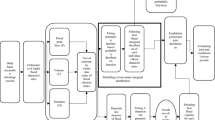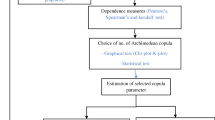Abstract
In this paper, a copula based methodology is presented for flood frequency analysis of Upper Godavari River flows in India. By using the specific advantages of copula method in modeling the joint dependence structure of uncertain variables, this study applies Archimedean copulas for frequency analysis of flood characteristics annual peak flow, flood volume and flood duration. To determine the best fit marginal distributions for flood variables, few parametric and nonparametric probability distributions are examined and the best fit model is adopted for copula modeling. Four Archimedean family of copulas, namely Ali-Mikhail-Haq, Clayton, Gumbel-Hougaard and Frank copulas are evaluated for modeling the joint dependence of annual peak flow-volume, and flood volume-duration pairs. The performance of two parameter estimation methods, namely method-of-moments-like estimator based on inversion of Kendall’s tau and maximum pseudo-likelihood estimator for copulas are investigated. On performing Monte Carlo simulation to assess the performance of copula distributions in modeling the joint dependence structure of flood variables, it is found that the developed copula models are well representing the observed flood characteristics. From standard statistical tests, Frank copula has been identified as the best fitted copula for both bivariate models. The Frank copula function is used for obtaining joint and conditional return periods of flood characteristics, which can be useful for risk based design of water resources projects.









Similar content being viewed by others
References
Ané T, Kharoubi C (2003) Dependence structure and risk measure. J Bus 76(3):411–438
Bárdossy A (2006) Copula-based geostatistical models for groundwater quality parameters. Water Resour Res 42:W11416. doi:10.1029/2005WR004754
Bhuyan A, Borah M, Kumar R (2010) Regional flood frequency analysis of North-Bank of the river Brahmaputra by using LH-moments. Water Resour Manag 24:1779–1790
Bobée B, Rasmussen PF (1994) Statistical analysis of annual flood series. In: Menon J (ed) Trends in hydrology, 1. Council of Scientific Research Integration, India, pp 117–135
Cherubini U, Luiciano E, Vecchiato W (2004) Copula methods in finance. Wiley, Chichester
Choulakian V, El-Jabi N, Issa M (1990) On the distribution of flood volume in partial duration series analyses of flood phenomenon. Stoch Hydrol Hydraul 4(3):217–226
Chowdhary H, Escobar LA, Singh VP (2011) Identification of suitable copulas for bivariate frequency analysis of flood peak and flood volume data. Hydrol Res 42.2(3):193–216
Clemen RT, Reilly T (1999) Correlations and copulas for decision and risk analysis. Manag Sci 45(2):208–224
Cunnane C (1987) Review of statistical models for flood frequency estimation. In: Singh VP (ed) Hydrologic frequency modeling. Reidel, Dordrecht, pp 49–95
De Michele C, Salvadori G (2003) A generalized Pareto intensity-duration model of storm rainfall exploiting 2-copulas. J Geophys Res 108(D2):4067. doi:10.1029/2002JD002534
De Michele C, Salvadori G, Canossi M, Petaccia A, Rosso R (2005) Bivariate statistical approach to check adequacy of dam spillway. J Hydrol Engg 10(1):50–57
Escalante C (2007) Application of bivariate extreme value distribution to flood frequency analysis: a case study of Northwestern Mexico. Nat Hazards 42(1):37–46
Favre A-C, Adlouni SE, Perreault L, Thiemonge N, Bobée B (2004) Multivariate hydrological frequency analysis using copulas. Water Resour Res 40. doi:10.1029/2003WR002456
Frees EW, Valdez EA (1998) Understanding relationships using copulas. N Am Acturial J 2(1):1–25
Genest C, Favre A-C (2007) Everything you always wanted to know about copula modeling but were afraid to ask. J Hydrol Engg 12(4):347–368
Genest C, Rivest L-P (1993) Statistical inference procedures for bivariate Archimedean copulas. J Am Stat Assoc 88(423):1034–1043
Genest C, Ghoudi K, Rivest LP (1995) A semiparametric estimation procedure of dependence parameters in multivariate families of distributions. Biometrika 82(3):543–552
Genest C, Rémillard B, Beaudoin D (2009) Goodness-of-fit tests for copulas: a review and a power study. Insur Math Econ 44:199–213
Goel NK, Seth SM, Chandra S (1998) Multivariate modeling of flood flows. J Hydraul Engg 124(2):146–155
Grimaldi S, Serinaldi F (2006) Asymmetric copula in multivariate flood frequency analysis. Adv Water Resour 29(8):1155–1167
Janga Reddy M, Ganguli P (2012a) Application of copulas for derivation of drought severity–duration–frequency curves. Hydrol Process 26:1672–1685. doi:10.1002/hyp. 8287
Janga Reddy M, Ganguli P (2012b) Risk assessment of hydro-climatic variability on groundwater levels in the Manjara basin aquifer in India using Archimedean copulas. J Hydrol Engg. doi:10.1061/(ASCE)HE.1943-5584.0000564
Kao SC, Govindaraju RS (2010) A copula-based joint deficit index for droughts. J Hydrol 380(1–2):121–134
Karmakar S, Simonovic SP (2009) Bivariate flood frequency analysis. Part 2: a copula-based approach with mixed marginal distributions. J Flood Risk Manag 2(1):32–44
Klein B, Pahlow M, Hundecha Y, Schumann A (2010) Probability analysis of hydrological loads for the design of flood control systems using copulas. J Hydrol Engg 15(5):360–369
Kojadinovic I, Yan J (2010) Comparison of three semiparametric methods for estimating dependence parameters in copula models. Insur Math Econ 47:52–63
Kumar R, Chatterjee C (2005) Regional flood frequency analysis using L-moments for North Brahmaputra region of India. J Hydrol Engg 10(1):1–7
Kumar R, Chatterjee C, Kumar S, Lohani AK, Singh RD (2003) Development of regional flood frequency relationships using L-moments for middle Ganga plains subzone 1(f) of India. Water Resour Manag 17:243–257
Maity R, Kumar DN (2008) Probabilistic prediction of hydroclimatic variables with nonparametric quantification of uncertainty. J Geophys Res 113:D14105. doi:10.1029/2008JD009856
Moon Y-I, Lall U (1994) Kernel quantile function estimator for flood frequency analysis. Water Resour Res 30(11):3095–3103
Nadarajah S, Shiau J (2005) Analysis of extreme flood events for the Pachang River, Taiwan. Water Resour Manag 19:363–374
Nelsen RB (2006) An introduction to copulas. Springer, New York
Parida BP, Kachroo RK, Shrestha DB (1998) Regional flood frequency analysis of Mahi-Sabarmati basin (Subzone 3-a) using index flood procedure with L-moments. Water Resour Manag 12:1–12
Rakhecha PR, Singh VP (2009) Applied hydrometeorology. Capital Publishing Company, New Delhi
Rao NG (2001) Occurrences of heavy rainfall around the confluence line in monsoon disturbances and its importance in causing floods. Proc Indian Acad Sci (Earth Planet Sci) 110:87–94
Raynal JA, Salas JD (1987) A probabilistic model for flooding downstream of the junction of two rivers. In: Singh VP (ed) Hydrologic frequency modeling. Reidel, Dordrecht, pp 595–602
Shiau JT, Wang HY, Tsai CT (2006) Bivariate frequency analysis of floods using copulas. J Am Water Resour Assoc 42(6):1549–1564
Sklar A (1959) Functions de repartition a n dimensions et leurs marges. Publ Inst Stat Univ Paris 8:229–231
Song S, Singh VP (2010) Meta-elliptical copulas for drought frequency analysis of periodic hydrologic data. Stoch Env Res Risk A 24(3):425–434
Wang C, Chang N-B, Yeh G-T (2009) Copula-based flood frequency (COFF) analysis at the confluences of river systems. Hydrol Process 23:1471–1486
Yue S (1999) Applying the bivariate normal distribution to flood frequency analysis. Water Int 24(3):248–252
Yue S (2000) The bivariate lognormal distribution to model a multivariate flood episode. Hydrol Process 14:2575–2588
Yue S (2001) A bivariate gamma distribution for use in multivariate flood frequency analysis. Hydrol Process 15:1033–1045
Yue S, Wang CY (2004) A comparison of two bivariate extreme value distributions. Stoch Env Res Risk A 18:61–66
Yue S, Ouarda TBMJ, Bobée B, Legendre P, Bruneau P (1999) The Gumbel mixed model for flood frequency analysis. J Hydrol 226(1–2):88–100
Zhang L, Singh VP (2006) Bivariate flood frequency analysis using copula method. J Hydrol Engg 11(2):150–164
Author information
Authors and Affiliations
Corresponding author
Appendix
Appendix
1.1 A1 Simulation of Random Samples from Bivariate Archimedean Copulas
The generation of random variates (u, v) from Clayton and Frank copulas involves the following steps:
-
1.
Generate two independent uniform U(0,1) random variates u and q.
-
2.
Set \( v = C_u^{{ - 1}}\left( {q|u} \right) \), where \( C_u^{{ - 1}}\left( {q|u} \right) \) is the inverse of conditional distribution \( {C_u}(v) = {{{\partial C\left( {u,v} \right)}} \left/ {{\partial u}} \right.} \). The functional relationships are given in Table 7.
-
Clayton and Frank copulas have closed form relationships for \( C_u^{{ - 1}}\left( {q|u;\theta } \right) \), whereas Gumbel-Hougaard (G-H) copula does not has closed form relation, hence \( C_u^{{ - 1}}\left( {q|u} \right) \) is solved numerically.
-
-
3.
The pair (u, v) forms the random vector drawn from the respective copula family C(u, v; θ).
-
4.
The desired (simulated) sample is given by \( \left( {x,y} \right) = \left[ {F_X^{{ - 1}}(u),F_Y^{{ - 1}}(v)} \right] \), where \( F_X^{{ - 1}}\left( \bullet \right) \) and \( F_Y^{{ - 1}}\left( \bullet \right) \) are inverse of marginal distributions F X (x) and F Y (y) respectively.
Rights and permissions
About this article
Cite this article
Reddy, M.J., Ganguli, P. Bivariate Flood Frequency Analysis of Upper Godavari River Flows Using Archimedean Copulas. Water Resour Manage 26, 3995–4018 (2012). https://doi.org/10.1007/s11269-012-0124-z
Received:
Accepted:
Published:
Issue Date:
DOI: https://doi.org/10.1007/s11269-012-0124-z




